Corona crisis loosened its grip in July to September, Finland's economic situation still weak compared to one year ago
In the July to September period, the seasonally adjusted volume of Finland’s gross domestic product increased by 3.3 per cent from the previous quarter. GDP adjusted for working days declined by 2.7 per cent compared to the third quarter of 2019. Examined at current prices, gross domestic product adjusted for working days was 1.5 per cent lower than one year ago.
Figure 1. Volume change of GDP from the previous quarter, seasonally adjusted, per cent
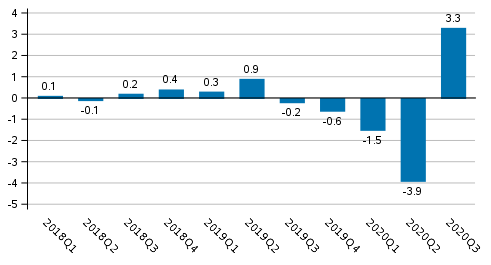
According to preliminary data compiled by Eurostat, gross domestic product in the EU area grew by as much as 11.6 per cent in the third quarter compared to the previous quarter. Both the collapse in the second quarter and the recovery from it in the third quarter were more moderate in Finland than in the EU area.
Output
The volume of total value added generated by all industries grew by 2.8 per cent from the previous quarter but decreased by 2.7 per cent from twelve months back.
Figure 2. Changes in the volume of value added generated by industries in the third quarter of 2020 compared to one year ago, working-day adjusted, per cent
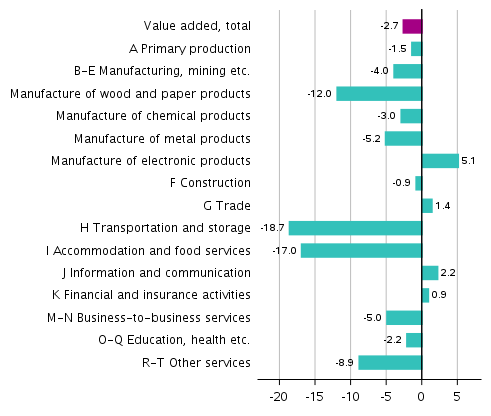
Figure 3. Changes in the volume of value added generated by industries in the third quarter of 2020 to the previous quarter, seasonally adjusted, per cent
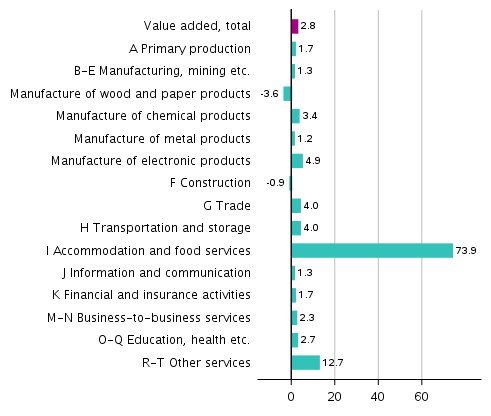
The volume of value added in primary production, that is, agriculture, forestry and fishery, declined in July to September from one year ago.
Output in manufacturing industries (incl. mining and quarrying, energy, water supply and waste management) grew in July to September from the previous quarter but was lower than one year ago. The forest, chemical and metal industries contracted from one year ago.
The construction industry has made a downturn: civil engineering is still growing but building construction has decreased in July to September both from the previous quarter and from one year ago.
In service industries value added grew from the previous quarter but remained lower than in the third quarter of 2019. The corona crisis has had a particularly strong impact on transport, and hotel and restaurant activities. In July to September, these industries grew clearly from the second quarter, when the effects of the corona crisis have so far been most drastic. However, in nearly all service industries value added remained lower in the third quarter than one year earlier. The industry of trade also grew from the year before, especially as retail trade increased clearly.
Imports, exports, consumption and investments
Total demand grew in July to September from the previous quarter but was still 6.1 per cent lower than one year ago. All demand items contracted from one year ago. Investments also decreased compared to the previous quarter.
Figure 4. Changes in the volume of main supply and demand items in the third quarter of 2020 compared to one year ago, working-day adjusted, per cent
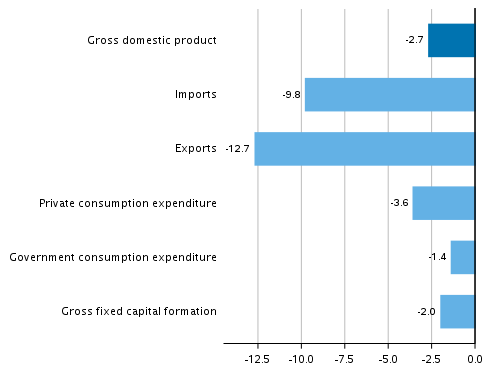
Figure 5. Changes in the volume of main supply and demand items in the third quarter of 2020 compared to the previous quarter, seasonally adjusted, per cent
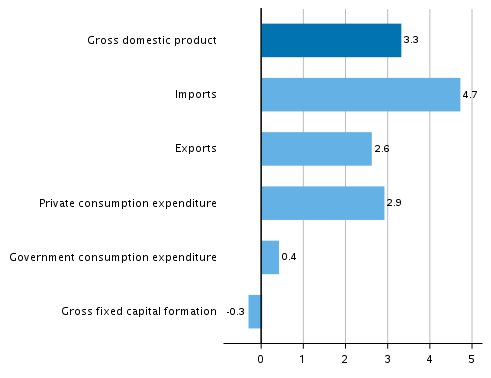
In July to September, the volume of exports grew by three per cent and that of imports by five per cent from the previous quarter. Compared to one year ago, exports decreased by 13 per cent and imports by ten per cent. International trade in services has suffered more from the corona crisis than exports and imports of goods, and the effect is still visible in the third quarter: exports of services decreased by 31 per cent and imports of services by 22 per cent from one year ago, while exports of goods went down by three per cent and imports of goods by four per cent. As a result of falling prices, the value of exports of goods at current prices was, however, nine per cent lower and the value of imports of goods 12 per cent lower than one year ago.
In the July to September period, private consumption grew by three per cent from the previous quarter but remained lower than one year ago. Consumption of durable consumer goods grew most, and consumption of services remained seven per cent lower than one year ago. Government consumption expenditure grew slightly from the previous quarter but remained lower than in the third quarter of the year before.
Gross fixed capital formation, or investments, decreased both from the previous quarter and the corresponding quarter of one year ago. Public investments grew by 15 per cent, but private investments fell by five per cent compared to the third quarter of 2019. Investments in machinery, equipment and transport equipment grew from the previous quarter but remained lower than one year ago. Investments in building construction decreased but investments in civil engineering grew clearly. Investments in research and development grew slightly from one year ago.
Employment, wages and salaries and national income
In July to September the number of employed persons fell by 2.0 per cent and that of hours worked by 0.4 per cent from one year back. From the previous quarter, the number of hours worked grew by 2.4 per cent.
According to Statistics Finland’s Labour Force Survey, the rate of unemployment for the July to September period was 7.7 per cent, while in last year’s corresponding period it was 6.0 per cent.
In July to September, the nominal wages and salaries bill of the national economy grew by 2.2 per cent from the previous quarter but decreased by 0.1 per cent year-on-year. Social contributions paid by employers decreased by 1.3 per cent from one year back.
The operating surplus (net), which in business bookkeeping corresponds roughly with operating profit, grew in the third quarter by 0.4 per cent from twelve months back. Gross national income calculated at current prices was 2.5 per cent lower than one year previously.
The available data
These preliminary quarterly data are based on the source information on economic development that had become available by 24 November 2020. The annual level data for 1990 to 2019 correspond with the National Accounts data released on 18 September 2020, except for those on the rest of the world sector (imports, exports, primary income from/to the rest of the world), which may have become revised. More detailed data for 2019 will be published on 18 December 2020, when the quarterly accounts database tables will also be updated.
Data concerning the fourth quarter of 2020 will be released on 26 February 2021. A flash estimate on GDP development for October to December will be released in connection within the December data of the Trend Indicator of Output on 16 February 2021.
Due to the benchmarking and seasonal adjustment methods, quarterly data may become slightly revised in connection with each release. However, the largest revisions take place during the two to three years following the release on a quarter, because final annual accounts data are published at a lag of around two years from the end of the statistical reference year. Seasonally adjusted and trend time series always become revised against new observations irrespective of whether the original time series becomes revised or not.
The quality description is available on Statistics Finland's website: http://www.tilastokeskus.fi/til/ntp/laa.html .
Methodological description of Quarterly National Accounts.Source: National Accounts 2020, 3rd quarter. Statistics Finland
Inquiries: Samu Hakala 029 551 3756, Antti Kosunen 029 551 3613, kansantalous.suhdanteet@stat.fi
Head of Department in charge: Mari Ylä-Jarkko
Updated 27.11.2020
Official Statistics of Finland (OSF):
Quarterly national accounts [e-publication].
ISSN=1797-9765. 3rd quarter 2020,
Corona crisis loosened its grip in July to September, Finland's economic situation still weak compared to one year ago
. Helsinki: Statistics Finland [referred: 23.12.2025].
Access method: http://stat.fi/til/ntp/2020/03/ntp_2020_03_2020-11-27_kat_001_en.html

